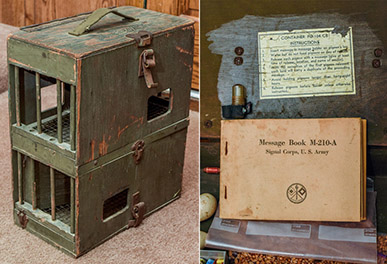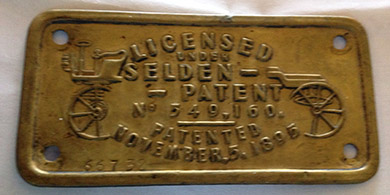 |
|
|||
 |
 |
|||
Copyright © Harry Rinker, LLC 2017 Questions
and Answers
QUESTION: I have a World War II U.S. Army Pigeon Signal Corp pigeon carrier. It was carried over the shoulder by an infantryman or strapped to the backs of paratroopers dropped behind enemy lines to get messages back to the front lines. My carrier is a four-bird carrier. The lid is incised “PG-104/CB.” I also have the period message book and army issued pencil. I have raised pigeons for most of my life. This is the one item that I own about which I am most curious. What can you tell me about it? – BE, Alliance, OH, Email Question 
ANSWER: The use of carrier pigeons as battlefield messengers dates back to the 6th Century. Cyrus, king of Persia, used carrier pigeons to keep in touch with parts of his vast empire. Julius Caesar sent messages back to Rome. During the siege of Paris in the Franco-Prussian War (1870-71), Parisians used carrier pigeons to send news about developments within the city. Some carrier pigeons traveled as far as London. Based on their success, carrier pigeons were part of military warfare theory by the end of the 19th Century. The United States Army Pigeon Service, also known as the Signal Pigeon Corps, began in 1917. Fort Monmouth, New Jersey, housed the U.S. Army Pigeon Breeding and Training Center from 1917 to 1943 and again from 1946 to 1957, when the Signal Pigeon Corps was disbanded. The Center was located at Camp Crowder in southwest Missouri from October 1943 until June 1946. During World War II, the U.S. Army trained approximately 54,000 pigeons, creating a division within the Veterinary Service devoted exclusive to maintaining the health and efficiency of these winged warriors. 36,000 pigeons were deployed overseas. In addition to the United States, the United Kingdom trained more than 250,000 carrier pigeons, supplying many to individuals working behind enemy lines. [For more information, see: https://en.wikipedia.org/wiki/War_pigeon and https://en.wikipedia.org/wiki/United_States_Army_Pigeon_Service] In 1943, the English PDSA (People’s Dispensary for Sick Animals) Dickin bronze Medal, honoring Maria Dickin founder of the PDSA, was issued to honor animals that demonstrated “conspicuous gallantry or devotion to duty while serving or associated with any branch of the Armed Forces or Civilian Defense Forces.” Thirty-two pigeons were honored between 1943 and 1949. “G. I. Joe” is the most famous of the American pigeons honored. [See: https://en.wikipedia.org/wiki/Dickin_Medal] Researching World War II military carrier pigeon carriers revealed a variety of different devices including a single canvas wrap that fitted around a pigeon’s body and was strapped to the front of a paratrooper to a collapsible pigeon container housed in a canvas carrying case. I also discovered several variations of the four-pigeon carrier. PG-104/CB was a four-pigeon carrier. PG-102/CB was a two-pigeon carrier. The website www.vassallomalta.com, contains an article on carrier pigeons that features a picture of a soldier with two four-pigeon carriers, similar to the one you own, strapped on his back. Thank you for providing several detailed pictures of your pigeon carrier. The instructions on the inside of the lid were fascinating. Although the homing instinct was critical, the instructions suggest another reason why the birds flew home: “#2. Water but do not feed pigeons on day of release.” Hunger is a strong incentive. There are several four-bird military pigeon carriers offered for sale on eBay. A seller is asking $450.00 plus $36.00 shipping for a model PG-51. Another seller is asking $99.00 for what appears to be a unit from the mid-1950s. The survival rate for your United States Army PG-104/ CB pigeon carrier is high. Several dozen have appeared for sale on eBay over the last five years. On May 6, 2013, an eBay seller sold a “PG-104/CB” unit identical to the one you own for $711.17. It had two military issued pencils, multiple small glass capsules that could be attached to a bird’s leg, and two pads, one for messages and the second containing tracing paper that could be overlaid on a map. The paper work is dated 1943. On June 30, 2014, a carrier without any paperwork brought $610.00. More recent sell through prices are lower -- $100.00 and $187.50. Individual M-210 message books sell between $11.00 and $14.00. Leg capsules with straps sell in the $55.00 to $65.00 range, although I did find examples that sold for under $35.00. Based on the above and an evaluation of the photographs that accompanied our email, the secondary market value of your U.S. Army World War II four-bird pigeon carrier is between $300.00 and $350.00 . QUESTION: I purchased a painting by William Swallow to present to a friend who is retiring. The person who sold it said the location was “The Bachman Farm.” Mr. Swallow was my friend’s art teacher. What can you tell me about the painting and its attribution? – CW, Berwick, PA, Email Question ANSWER: William Weldon Swallow is one of tens of thousands academically trained local artists whose claim to fame rests primarily within a fifty-mile radius of where he lived. William Weldon Swallow (born September 30, 1912, Clark’s Green, a Scranton suburb; died May 26, 1962) taught art at Parkland High School, located north of Allentown, Pennsylvania. Swallow’s primary claim to fame was his ceramics. The Metropolitan Museum of Art purchased “The Way of the Red Clay,” a sculpture that won first prize at the National Sculpture Society’s 11th Annual Ceramic Competition. During his career, Swallow exhibited at the Associated American Artists Gallery, Carnegie Museum, Montreal Museum, Pennsylvania Academy, and museums in many major American cities. In addition to ceramic sculptures, Swallow did mobiles, paintings (primarily landscapes), and watercolors. He lived in a farmhouse near the corner of Cedar Crest Boulevard and Walbert Avenue in Allentown. [See: http://articles.mcall.com/1996-05-12/entertainment/3091978_1_swallow-everson-museum-art-department] As a local painter, Swallow did not wander far for his subject matter. In March 2007, Alderfer Galleries sold a 20-inch by 16-inch oil painting entitled “Farm Scene in Wernersville” for $1,955.00. Bachman is a common name in Pennsylvania’s Lehigh Valley, thus finding the exact location may prove difficult. I recommend calling the Lehigh County Historical Society and talking with the librarian and/or curator. Ask them if they have any knowledge of a “Bachman Farm.” The Alderfer price is the highest value I found for a Bachman painting. The news goes downhill from there. Skinner in Boston sold a 20-inch by 16-inch landscape for $1,778.00 on September 12, 2008. Alderfer sold a 28-inch by 21-inch “Farm Scene” for $380.00 on December 13-15/2011. Swallow paintings offered at auction between the 2008 Skinner sale and the 2011 Alderfer sale failed to meet reserves as did more recent offerings. Swallow is an artist whose “hot” collecting streak was very short lived . QUESTION: I have a three-inch by one-inch stamped brass plaque that reads: “LICENSED / UNDER/ SELDEN / PATENT / No. 549,160 / PATENTED / NOVEMBER 5, 1895.” The plaque has holes in each of the four corners. “66732” is stamped above the lower left corner edge. I found this in a parking garage. Is it possible it is from an old Selden motor? -- TS, Reading, PA, Email Question 
ANSWER: A close examination of the image you sent reveals the answer is no. It is a fantasy piece, an object that never existed historically. George B. Selden of Rochester, New York, did receive Patent No. 549,160 on November 5, 1895, for an “Improved Road-Engine.” Pictures exist of Selden in a full-size working model of a car containing his engine. This appears to be the only automobile equipped with the Selden engine. There are a number of clues your plaque is a fantasy piece. First, it looks new. While it has some patina from sitting around, it has no wear or other aging marks. The screw holes are perfectly round, not something likely to happen if the plaque was removed from a working engine. The stamped number near the lower left edge would not have existed historically. It was added to give the impression of a serial number. Your plaque is a novelty piece. Its value is minimal, less than $5.00 on a bad day and less than $10.00 on a good day . Harry L. Rinker welcomes questions from readers about
collectibles, those mass-produced items from the twentieth and twenty-first centuries.
Selected letters will be answered in this column.
Harry cannot provide personal answers.
Photos and other material submitted cannot be
returned.
Send your questions to: Rinker on Collectibles, 5955 Mill
Point Court SE, Kentwood, MI 49512.
You also can e-mail your questions to
harrylrinker@aol.com.
Only e-mails containing a full name and mailing address
will be considered.
You can listen
and participate in
WHATCHA GOT?, Harry’s
antiques and collectibles radio call-in show, on Sunday mornings between 8:00 AM
and 10:00 AM Eastern Time.
If you
cannot find it on a station in your area,
WHATCHA GOT?
streams live on the Internet at www.gcnlive.com.
SELL, KEEP OR TOSS?: HOW TO DOWNSIZE A HOME,
SETTLE AN ESTATE, AND APPRAISE PERSONAL PROPERTY
(House of Collectibles, an imprint of Random House Information Group, $17.99),
Harry’s latest book, is available at your favorite bookstore and via
www.harryrinker.com.
|
||||